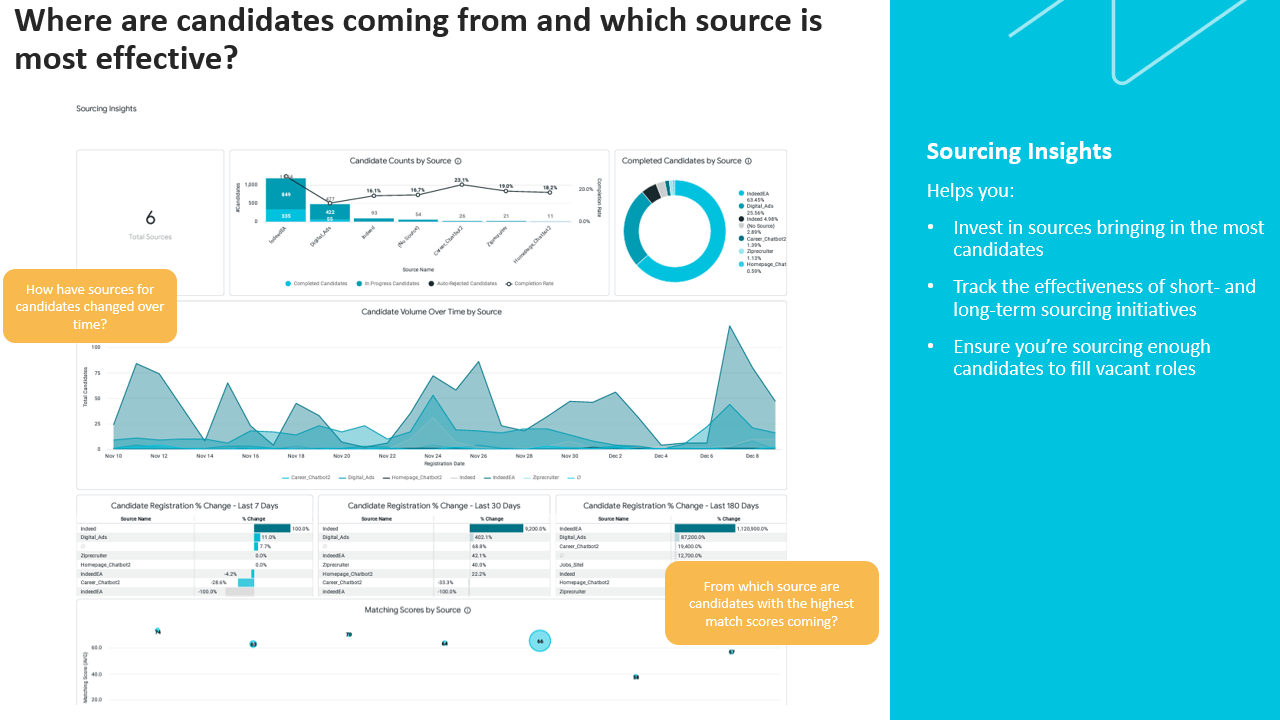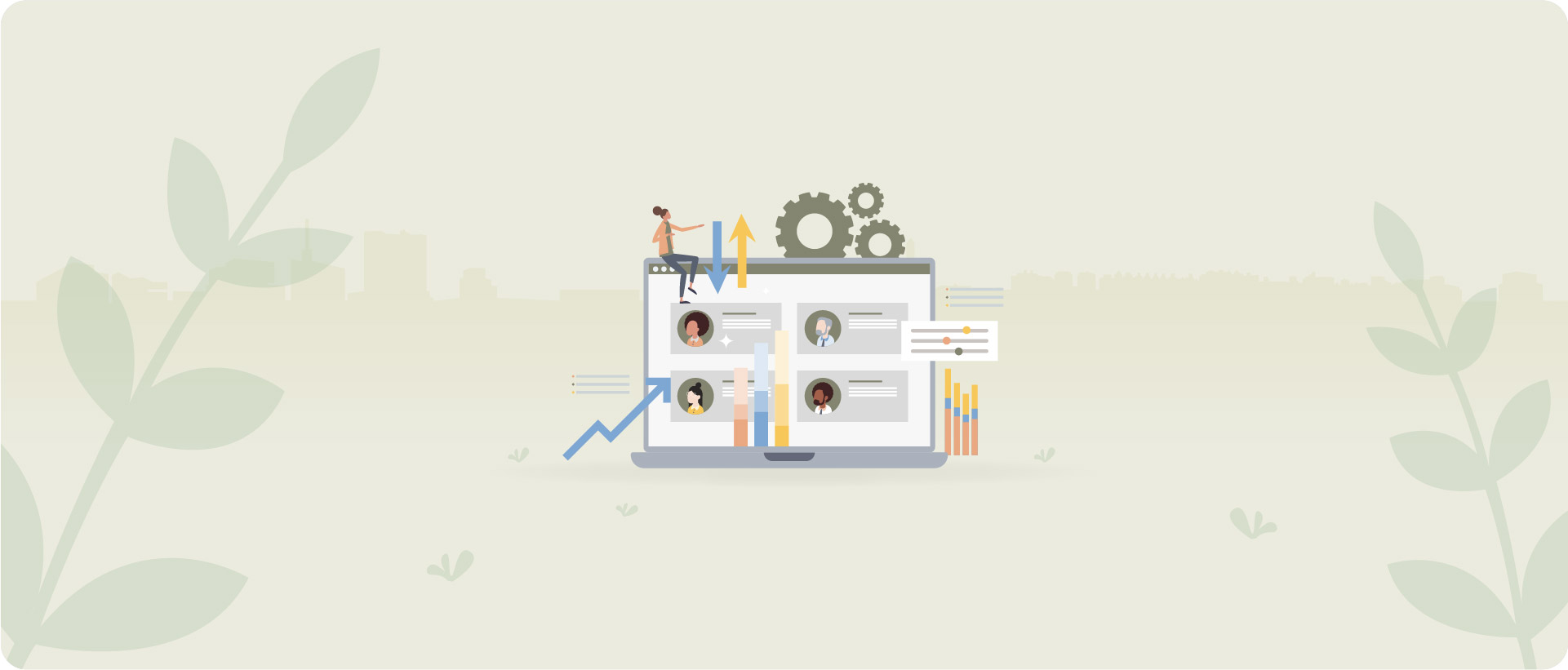As technology makes it easier to collect, analyze, and act on the wealth of data available to recruiting teams, it’s more important than ever to take the next step with data. 76% of talent acquisition professionals say that their recruitment strategies are more data-driven than before, according to Recruiting Daily.
Without robust data related to recruiting and talent initiatives, your organization will continue to fall behind when it comes to:
- Understanding how effective your process and strategies are (like hiring quality).
- Measuring how efficient your recruitment is (like time to hire).
- Optimizing return on investment (like reducing hiring costs).
- Competing for talent (like against employers with great candidate experience).
- Demonstrating HR’s impact (like connecting talent acquisition KPIs to business growth).
First, let’s start with what data-driven recruiting is. Then we’ll dig into some examples of how leveraging data can benefit your talent teams and your organization’s goals as a whole.
What's in?
What is data-driven recruitment?
Data-driven recruitment is when recruiting professionals use data analytics to plan and carry out their recruitment processes. This objective way to inform recruitment strategies and tactics leverages data to help improve outcomes throughout the talent acquisition life cycle.
Consider something like time to hire. At the top level, this key recruiting metric gives real-world insight into how long your process takes. Go a level deeper and it can tell you which individual sources tend to bring in candidates who accept their offer faster. Shifting spend from a lower performing source to this source with faster time to hire directly supports competing for fast-moving talent.
Ready to jump into some benefits? Here are 4 advantages data-driven recruitment, one for each of the planning, sourcing, screening, and selecting stages of recruitment.
Like what you see?
Don’t miss out. Subscribe to our quarterly digest to get the latest TA and TM resources delivered right to your inbox.
1. Benefit of data-driven recruitment planning: Increased talent pools
To find the right fit for a role, start by defining what good fit is. During vacancy intake, collaborate closely with the hiring manager so you’re clear on the ideal candidate profile. Otherwise, every step after this takes you farther from the talent you actually need. That slows down hiring and wastes valuable recruiter time, which contributes to recruiter burnout.
But what’s the right data to successfully define the ideal candidate? Adopting a skills-based approach can expand candidate pools by 10x, according to PwC.
What data to track: Dr. Ben Porr, our Chief Customer Officer, discussed the importance of gathering and utilizing skills data in our 2024 HR Trends webinar. What’s more, McKinsey notes that hiring for skills is 5x more predictive of job performance than hiring for education and 2x more predictive than hiring for work experience.
Example: Here’s an example of how leveraging skills data can boost candidate pools. When Paramount’s advertising team implemented our gamified behavioral assessment, they increased applications 83% compared to baseline.
Helpful resources:
2. Benefit of data-driven recruitment sourcing: Better sourcing ROI
Many employers rely on a variety of sources to recruit talent, from job boards to referrals to internal talent marketplaces. Tracking key performance data of each source enables your team to understand return on investment (ROI) and to reallocate time and money on sources that deliver the quality and quantity of candidates you want.

What data to track: To find source quality, take a look at the number of high-quality candidates coming from each source. Similar to identifying your number of qualified candidates, you want to look at where each high-quality candidate (or the candidates who make it furthest in your recruitment process) is coming from.
Example: With a robust analytics resource like Harver’s Insights Dashboard (example above), your team can:
- Track core recruitment KPIs to measure and demonstrate performance
- Unlock real-time visibility into candidate counts, completions, and more
- Reallocate spend to higher performing sources for ROI optimization
To learn more about what’s possible with Harver’s Insights Dashboard, watch our quick video for an overview of key insights available.
Helpful resources:
3. Benefit of data-driven recruitment screening: Higher new hire retention rate
Traditional screening methods like resume sifting are still common. Though it is worth asking: are resumes are a dead screening method?
Imagine you’re filling an entry-level frontline retail role, which can often struggle with quality of hire and early retention challenges. Narrowing down your candidate pool would be more reliable and efficient if you had objective signals that tie back to job performance and likelihood to remain within the role.
What data to track: New hire retention (for instance, first 30-days or at the 30/60/90-day marks). Calculate this by dividing the number of employees in the role who leave within the time frame by the total number of employees in the role during that same period, then multiply by 100 to get a percentage.
Here’s an example of the formula in use:
(5 employees who attrited / 10 total employees in role = .5) x 100 = 50% early attrition
Example: One effective way to predict early attrition and quality of hire is by implementing situational judgment tests. See how a video-based situational judgment test has helped Valvoline hire and retain the staff they need to satisfy customers.
Helpful resources:
- Situational judgment tests: Clear & reliable predictors of performance & attrition
- The holistic approach to decreasing attrition rates in hourly hiring
4. Benefit of data-driven recruitment selection: Improved quality of hire
Once you’ve narrowed down your candidates, it’s time to select who makes it to the interview process. Objectivity here helps to identify the best match to improve day-one performance and quality of hire.
In addition to a structured interview, we recommend leveling the playing field further by using assessments to objectively measure job-related skills and traits. One reason why: 78% of HR professionals note that quality of hire has increased due to their use of assessments.
What data to track: Quality of hire. There are multiple formulas available to calculate this key recruiting metric. Check out Harver’s guide to quality of hire for 3 examples, clearly spelled out to enable data-driven decisioning.
Example: Here’s an example of how leveraging skills data can improve quality of hire. One of our financial services customers wanted to drive performance of their personal bankers. By prioritizing best-fit candidates assessed for soft skills, this customer with 500+ global branches increased sales performance by 24%.
Helpful resources:
Stop guessing,
Start data-driven hiring.
Learn how you implement a modern candidate selection process, that is: streamlined, experience-driven and backed by data.

Your next step for data-driven recruitment
To learn more about modernizing your recruitment, grab our free e-book Complete Guide to 21st Century Candidate Selection.
You can also schedule a demo to learn more about how assessments and automation can improve your recruiting metrics, business KPIs, and more.


